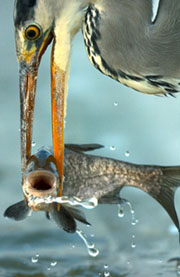
|
The Competition
The annual Wildlife Photographer of the Year Competition brings together the finest nature pictures taken internationally and, by showcasing these outstanding images, celebrates the beauty, wonder, and importance of the natural world. The Competition is organized by BBC Wildlife Magazine and The Natural History Museum, London. History When the competition began in 1964 it had only three categories: Mammals, Birds, and Other Animals. The 500 entries received in that first year pale in comparison to the 18,000 regularly received in recent years. Those early entries were mainly record photographs, documentary in style, whereas today a clear shift in emphasis has occurred with wildlife photographers looking at the natural world with far more artistic eyes. This shift has, in part, been credited to the competition, which dramatically extended its scope in 1981, when BBC Wildlife Magazine decided not only to find new photographers but also to raise the status of wildlife photography. Aesthetics were added to the main judging criteria, and an emphasis was placed on photographs taken under wild and free conditions. The range of categories was also extended and the competition opened up to young people, aged 17 or under, to inspire a new generation of photographers. However, the public profile of the competition remained low. In 1984, the partnership between The Natural History Museum and BBC Wildlife Magazine was formed and the competition began to capture the public's imagination. With a high-profile exhibition at the museum, thousands of people were now able to see the photographs in their full glory. The partnership also led to the development of a full gala awards ceremony, with category winners flown in from around the world. For the first time, the world's best wildlife photographers were provided with a grand stage on which to showcase and celebrate their achievements. As the brand grew, international interest and participation continued to increase and the competition matured from its largely UK-focused origins to its current status as the largest and most prestigious competition of its kind in the world. The competition is now an eagerly anticipated event for hundreds of thousands of people around the world. The competition Web site showing the winning entries received over four million hits from 64 countries in the first month following the awards announcement in 2001. The exhibition now tours the world and has visited more than 38 countries, including the USA, Brazil, Spain, Australia, UAE, China, and Morocco, and is a regular event in many museums, galleries, zoos, science centers, and other venues across the globe. With each passing year the standard of photography continues to rise, and audiences both old and new are captivated by this spectacular celebration of the world's best wildlife photography. Across arid deserts, over soaring mountains, through dense tropical forests, and out into the open oceans, these images are not just pictorial ambassadors for our natural world but also show the artistic perfection, technical expertise, and natural beauty captured in a moment of brilliance by the photographers. The competition simply celebrates that brilliance and shows it to the world. |
 Death Squeeze Bence Máté |
